This guide was written by @Fluffiness
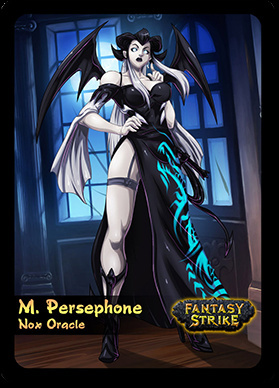
Persephone is a character whose low damage output is offset by her ability to recur her best cards, and to always have all her options on the table. She also excels at denying the opponent the use of their abilities and best cards, always stacking the deck in her favor. If you enjoy a complicated character who always has options while denying the opponent theirs, Mistress Persephone might be for you.
Pros
- Relatively fast attacks (X.4 speed normals, 0.2 speed Q, 0.4 speed AA).
- Her innate lets her recur her best cards and build a hand without blocking.
- One of the strongest endgames in Yomi.
- Has some of the best dodge follow-ups in the game (thanks to her A and innate).
- Can easily disrupt the opponent’s hand and abilities.
- Always has access to Aces, since she is not afraid to power up.
Cons
- Generally low damage output.
- Low life.
- Her card engine can break down quickly if she can’t get double KD.
- Can suffer greatly if she does not have enough cards.
Innate Ability – Dominance

Persephone’s Dominance is the backbone of her gameplan. When her opponent is knocked down, she may recur a card from the discard. A second consecutive Knockdown lets her fetch four different cards! No other character can get back options as easily as Persephone. Persephone is a fragile character, at 75 health, who relies on getting successive combat wins ending in Knockdown to develop a massive card advantage over her opponent. Luckily for her, she can get Knockdown off of most of her combat options: throws (7, 8, 9, 10, K), dodges (2, 3, 4) and attacks (J, AA). Since block cannot give Persephone Knockdown, strongly consider dodging instead of blocking. Unlike most characters, Persephone is also not afraid to power up early and with relatively powerful cards, since she can recur them later thanks to her innate.
It is important to remember that Persephone recurs cards before the cards revealed in combat are discarded.
What to Recur from Dominance:
Persephone, once she lands a Knockdown, will have to choose which cards she wants to retrieve from her discard. Generally, there are several cards that she will want to recur before all others:
- Options that she’s missing. If Persephone has no throws, fast attacks, or dodges, she will want to recur the option that she is missing. In the case of throws, always take the fastest throw you can (unless K and 7 are effectively the same speed. Then, take K).
- Aces. Persephone relies heavily on her Aces to make all her options threatening. As such, she always wants to have one or two in hand. When powering up for Aces, it is sensible to leave one in the discard so that it can be recurred through Dominance.
- Cards that will let you power up for Aces. Since Persephone can only recur one of each rank per turn, taking a card from the discard that will let her get another Ace is usually a good idea.
- 10s and 9s. Persephone makes a lot of use of these cards, and she wants consistent access to her abilities.
- Jacks. If Persephone has none of the other options to recur, getting back Jacks will let her threaten to end a combo with Rapid Lashes if her opponent is close to death.
Do as Told
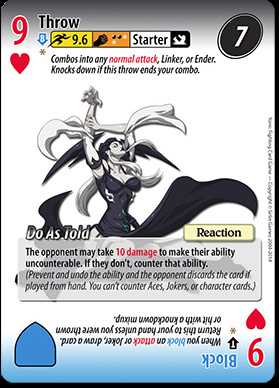
Persephone’s soft counter. When an opponent plays an ability, she may play Do as Told to force them to pay 10 life, or else cancel the ability. Do not be afraid to use her counter, since she will probably be able to recur it later, but be careful of using it on a weaker ability (Lum 7, Quince 10…), since it might be bait to let the opponent’s stronger ability go through. It is also important to remember that her counter cannot be used more than once on the same ability if the opponent pays the 10 life.
Bare Your Soul
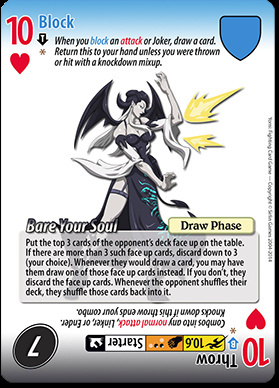
Persephone’s 10* lets her draw the top three cards of the opponent’s deck, letting her control which cards the opponent gets and making sure that they do not have the options necessary to beat her, all while giving her knowledge on the contents of their hand.
Bare Your Soul also lets Persephone send the opponent’s best cards to the discard. If she has two 10*s in hand, she should strongly consider playing both at the same time if her opponent has a good card flip due to Bare Your Soul.
This ability grows stronger as the opponent’s hand size shrinks, since Persephone gains more knowledge on the hand the less cards there are in it, so if the opponent has a large hand, it might be worth it to save the ability.
Cards worth sending to the discard
Since Bare Your Soul can only hold three cards at a time, Persephone can play multiple copies to eliminate opponent’s cards. Some cards worth eliminating:
- Jokers. Opponents are less likely to be able to Blue Burst Mistress’s Command, or to Gold Burst for Aces.
- Attacks faster than AA. Making AA the dominant attack makes sure that you will win attack clashes.
- Throws faster than her 7. Making 7 the dominant throw means that you will win throw clashes.
- Cards with abilities on them: Several abilities are very dangerous to Persephone’s gameplan and are sometimes worth discarding.
Mistress’s Command
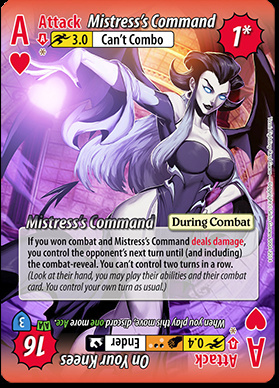
Persephone’s A is her signature ability, letting her take control of her opponent for a turn, up until the combat reveal, giving her full knowledge of her opponent’s hand and a guaranteed combat victory, and letting her eliminate their best card and abilities. When using MC, you generally want to play all the opponent’s abilities that you can, so as to shrink their hand and make those abilities useless. Persephone is usually aiming to land MC early in the game to establish a huge advantage over her opponent.
Mistress’s Command provides great synergy with her other abilities, letting her use Bare Your Soul to maintain her knowledge and control of the opponent’s hand for longer, and letting her force her enemy to pay 10 life to use their abilities to no effect through her 9*.
On a Mistress’s Command turn, you should:
- Play all the opponent’s Draw Phase abilities while using Do as Told to make the opponent lose 10 life as much as possible. This makes the opponent lose cards and life while wasting their abilities.
- Check for hardlock options. If any exist, or almost exist, execute. (A hardlock would be denying the opponent all even blocks and attacks faster than or equal to 2.4, for example).
- If there is no hardlock option, play the most valuable option in the opponent’s hand that you can beat for a KD (sometimes this is a 10 with an ability, other times it’s their fastest Throw. If you have a large hand and a Dodge, this could be a Joker, solitary reversal, or Multi-Ace super.
- End your MC with a knockdown. Power Lash vs. Throw or 8-Throw vs. Block/Dodge are both amazing. If they have less than 40 life, consider K6J++ or some variation to bring them to zero hp, or to within 1 hit from a Q/Throw mixup.
The threat of Mistress’s Command also encourages the opponent to block and dodge more, to avoid getting hit by it, which opens up Persephone’s throw game.
Off a dodge, it is important to consider whether to go for Knockdown or for Mistress’s Command, as both play into Persephone’s general strategy.
Her Cards
Persephone’s normal attacks are speed .4, which is faster than average, and her throws are speed .6, which is average speed.
Her 4 combo points and lack of linkers don’t let her make very damaging combos, but her easily recurred KD AA ender and her innate make damaging combos mostly unnecessary.
2: Attack/Dodge
Persephone has only 12 dodges, so this card will often see use as a dodge, especially since it does not end in Knockdown unless Persephone also has AA in hand. It is also Persephone’s fastest even normal, so it can be used to mixup opponents’ blocks when they are KD.
3: Attack/Dodge
This card will primarily see use as a dodge, but it is also Persephone’s fastest odd normal attack.
4: Attack/Dodge
This card will also be primarily used as a dodge, but it is also a necessary card if Persephone wants to make straights. You should rarely attack with a raw 4. It can often be powered up if Persephone has a 2 in hand.
5: Attack/Block
This card is primarily a block. Since Persephone’s blocks are often her weakest option, it will often be powered up or used as a pumper card for her J attack.
6: Attack/Block
This card is primarily a block. It is okay to power up using this card.
7: Throw/Block
This card is Persephone’s fastest throw, and as such should rarely be used as a block, is valuable and worth recurring. However, in matchups where there is no difference between a 7.6 speed throw and an 8.0 speed throw, it becomes okay to power up with 7s if strictly necessary.
8: Throw/Block
This is Persephone’s third fastest throw, and as such it is an okay card to block with, or to power up with. This should also be the slowest throw that Persephone uses.
9: Throw/Block*
Persephone’s 9 should be primarily used for its ability, since it loses to most throws and to attacks. Only use if you have no other throws.
10: Throw/Block*
Persephone’s 10 should mostly be used for its ability, since it loses to most throws and to attacks. This is Persephone’s slowest throw. However, it can also be used as a block if necessary, since Dominance should let you recur it.
Jack: Rapid Lashes: Attack 7+4 (+2 Any) (3) dmg, speed 2.4, 1 CP Ender // Power Lash: Attack (KD) 10 (3) dmg, speed 4.0, Can’t Combo
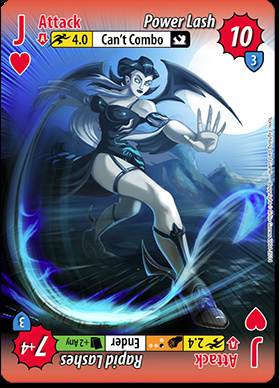
Persephone’s slow J is an excellent dodge followup, dealing 10 damage and gaining Knockdown. It should rarely be revealed raw, except on a strong throw read or against a grappler.
Persephone’s fast J is her most damaging combo ender, but is not card efficient and does not give KD, so it should be saved for late-game, when it is lethal, or close to lethal.
Queen: Rising Pleasure: Attack 9 (2) dmg, speed 0.2, 3 CP Ender
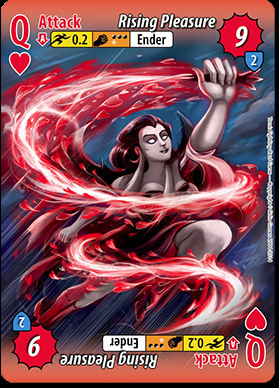
Persephone’s fastest reversal, it beats most of the opponent’s attacks when Persephone does not yet have consistent access to AA, and can fend off an aggressive player. Once Persephone does have reliable access to AA, Qs can become power up fodder, since they don’t fit in her general game plan.
King: Wild Ride: Throw (KD) 9 dmg, speed 8.0, 2 CP Starter
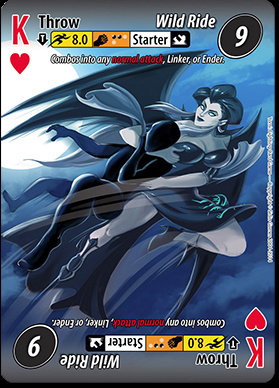
Persephone’s second fastest throw, it is also her most damaging throw, and usually a valuable card. In matchups where the speed difference between her K throw and her 7 throw doesn’t matter, this becomes her most valuable throw by far. When the speed difference does matter, 7s are generally better to recur than K, and K can be used to power up with.
*Mistress’s Command: Attack 1 dmg, speed 3.0, Can’t Combo // On Your Knees: Attack (KD) 16 (3) dmg, speed 0.4, 2 CP Ender AA // Mistress’s Command

Persephone’s Aces are by far her strongest cards, and she usually wants access to them at all times because of how important they are to her strategy.
Mistress’s Command is Persephone’s signature ability. A relatively slow attack at speed 3.0, it is a great dodge followup, and a good card to play when you read a throw or slow attack. Mistress’s Command gives you a free combat win next turn, while letting you get rid of your opponent’s best card and learning their hand.
Additionally, if you have a known Ace, the opponent is encouraged to Blue Burst when they lose to a Dodge.
On Your Knees is a very fast attack that usually beats or trades with your opponent’s attacks. Persephone’s AA is an essential part of her strategy, since it lets her end absolutely any combat in KD for 16 extra damage, and is very easily recurred. As such, Persephone’s innate should be used to make sure she always has access to AA. You can also try to mixup your opponent’s block when they are KD before tacking on AA for the extra Knockdown. Always try to keep an AA in hand, since it is so central to your game plan.
Jokers
Persephone can easily access her aces, and has a low life total, so she generally wants to use her Jokers as a Blue Burst to escape damage.
Opponents will generally facedown when Persephone dodges an attack out of fear of Mistress’s Command. It is important to figure out when they are bluffing, when to go for MC, and when to go for KD.
If the opponent is standing and does not facedown: go for MC. It will give you all the advantages of KD, plus it will let you degrade the opponent’s hand for high damage.
- If the opponent is standing and facedowns a card, determine the likelihood of them having and playing a Joker. If you think they are bluffing, go for MC. Otherwise, go for KD. The larger your hand, the more you want to go for MC. The smaller the opponent’s hand, the more you want to go for MC.
- If the opponent is KD and does not facedown a card, it’s a judgement call. If you have a low hand, or are missing an option, you might want to go for KD. If you have many cards, it might be better to aim for MC. If the opponent has few cards, it might also be better to aim for MC.
- If the opponent is KD and facedowns a card, go for KD. You’ll recur 4 cards and hopefully deal damage, while an MC breaks your Dominance loop, and might not work if they actually Blue Bursted.
Playing as Persephone
First of all, be prepared to always be thinking. A lot of situations that at first glance look very similar are actually very different, at least in terms of what you should play. As some characters, you can sit back and block for a turn, or throw out a fast option mindlessly. Not so as Persephone. If you get lazy with her combats or anything else, you will lose (more), since she has a careful gameplan that can get wrecked easily.
However, you still have several things going for you. First, you have an outstanding innate. It lets you be offensive while letting you control what options you have, which is good. You also have a powerful single ace, which is difficult to play around.
As Persephone, your goal is to get the opponent Knocked down while constantly degrading their hand quality through repeated used of MC or BYS, ideally achieving a hardlock. However, hardlocking an opponent is pretty rare, so she has to content herself with merely giving herself all the dominant combat options.
The game
Early game you have very few cards worth recurring in your discard, meaning your innate is useless. This sucks. In order to fix this, you have two options: don’t use your innate, or put stuff in your discard. Luckily for you, there are several options in your kit that do both of these things, and importantly, they are not helpful for your lategame Knockdown loops. Qs are good in this stage to give you time to set up for the later parts of the game by making sure you aren’t thrown or hit by attacks. In this stage, Persephone also wants to limit her attacks as much as possible so that her opponent cannot build a hand by blocking.
Here are the things to consider on early turns:
- Block. This is good because it lets you get more cards without using your innate. Also, it has little downside since if your opponent tries to be tricky and throws they will have one less throw to deal with your super great dodges and your lategame dodge/throw mix. Don’t be afraid of blocking a bit early, though you only need so many cards before you start doing other things.
- Q. Play this because it is useless to your Knockdown loop (unless you have a pair) and often wins combat. If your opponent is playing a block heavy character, use this less, since it lets them build a hand without helping you build hand too.
- Ace. If you manage to hit a naked A t1, life is good, since you can really mess with their hand when they likely have few good options. Do this mainly vs. throw heavy characters like grapplers or rushdown characters, since naked A is likely to be outsped.
- Dodge (into A). This is good, and do it mainly vs. people who respect your throws a lot and attack a lot. Persephone is incentivized to land a Mistress’s Command, since it gives her a huge advantage that lasts a long time, and dodging into it means that it will not be outsped.
- Throw. Your throws are more conducive to building hand than most characters’, and you can burn fast throws so easily and then get them back. Also, the opponent has to block or dodge to be safe from MC, so throw is a good option.
- Straights: When else are you going to play them? You need aces, after all, and normal draw is pretty good for Persephone.
Continue to play these options until you run out or have enough in discard to start doing other things.
After a few turns, you should have several cards in the discard, either because of combat, power up, or ten ability. Now, your throws are better and you can dodge into Knockdown. Now that you have done your first combats, it’s time to get more stuff into the discard. “Free” discardable cards are 10s and multiples, since you can power the multiples and play the tens during draw phase. However be careful to not put so many cards into the discard that your hand size is uncomfortably low.
Persephone’s innate becomes more powerful as more cards enter her discard, and it is time to shift into loop mode. Ideally on the first few turns, you landed a throw or a half-decent dodge, and if so half of your pie is already baked. If not, maybe consider doing that before you start tossing things into your discard. You will be trying to find ways to get a double Knockdown. Ideally, Persephone will be drawing enough cards from her innate so that she never has to block again.
Additionally, unlike other characters, Persephone is not afraid to use her best cards each turn, since she will be seeing them again. So a slow throw is almost never better than a faster throw, and Persephone should not be afraid of representing raw AA. And recurring your fastest moves means that Persephone gets faster as the opponent uses up their fastest moves.
Finally, when Persephone has access to AA reliably, she can threaten the AA/throw mixup every turn, hopefully recurring BYS enough so that she knows her opponent’s hand. She should continue this mixup until the opponent dies, or gains an attack faster than AA, in which case she should sprinkle in dodges to catch those reversals. At this stage of the game, dodge into MC also becomes a much stronger move, since it can guarantee Persephone a lethal from 31 health.
Looping the Opponent
Now it is time to talk about set play and loops. Here are the things you should think about while deciding what to play vs. a KD opponent:
- What will I retrieve? Ideally, you retrieve things that let you threaten AA, and misc. good other things, like dodges, fast throws, Q, J (lategame), mixup normals, more powerup fodder for if your AA misses, and abilities. By the time your combat card hits the table, you should have planned, like a rushdown character plans their combos, what to pull should you win combat.
- How will my hand look next turn if I hit/miss my loop? Factor in your answer to the above, and also consider how screwed you are if you don’t get the KD. Remember, even if you have AA in hand, sometime dodging is the better answer to opposing attacks, or a mixup normal is better against their fast throws. If you would have a very low and/or poor hand after losing with an option, strongly consider not playing it.
- Can I “enrich” my discard for a better pull should I hit my loop? Powering up and using your 10s is generally a good way to enrich your discard. If, after playing your 10 and successfully getting KD, you would return your 10, play your 10 if you do not already have a 10 in the discard. Powering up is good for a small discard because it puts cards in the discard and lets you “prepay” your aces for future turns.
- Persephone also needs to keep in mind which options are most likely to beat the opponent’s play and result in another KD. While specifics vary against different characters, here are the plays that she should most often be considering:
- Dodge. This beats the opponent’s reversals and slow attacks, but loses to throws and blocks. Use it if you are confident that your opponent will attack. This is also the only option that beats Gold Burst, which the opponent might do if they have no reversals.
- Even Normal. This beats the opponent’s throws, slow attacks, and odd blocks, but loses to reversals and even blocks.
- Odd Normal. This beats the opponent’s throws, slow attacks and even blocks, but loses to reversals and odd blocks.
- Throw. This beats all the opponent’s blocks and slow throws, but loses to all attacks and can lose to faster throws.
Credits
@Redless for helping me with the title and gameplan section.
@mi-go hunter and @mysticjuicer for critiquing and proofreading me.
@Shax because your tournament inspired me to write this guide.
This guide was written by @Fluffiness